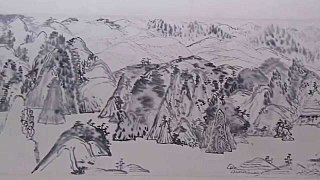Gion Nankai
Gion Nankai ( Japanese 祇園南海 , actually Gion Yu ( 祇園瑜 ) further stage name : Horai ( 蓬莱 ) Kanraitei ( 観雷亭 ) Kikyo ( 箕踞 ) Rishōhin ( 履昌〓 ) Shoun ( 湘雲 ) Tekkan Dojin ( 鉄 冠 道人 ) and Tekkanjin ( 鉄 冠 人 ); born 1676 in Edo ; died October 26, 1751 ) was a Japanese Confucianist, poet and painter of the Nanga movement in the Edo period .
life and work
Gion Nankai was the eldest son of Gion Jun'an, a doctor who served the Kishu-Tokugawa . From the age of thirteen he was instructed by the Confucianist Kinoshita Jun'an ( 木 下 順 庵 ; 1621–1699) and, with Arai Hakuseki , Muro Kyūsō, is one of the "Ten Disciples of Kimuras" ( 木門 十 哲 , Mokumon (no) Jittetsu ). In addition, he excelled in the fields of poetry and prose. He became a teacher of Confucianism and in 1713 head of the school.
However, at the age of 24, Nankai was banned from school for bad behavior, the exact reasons not being known. Ten years later he was pardoned and returned to his post as a Confucian scholar in Wakayama . The following year he oversaw a Korean mission with excellent results, resulting in a salary of 200 koku . In 1713 he was entrusted with the management of the newly founded Han school .
During this time in Nankai, Nankai began to study Nanga painting of the Yuan and Ming times , using textbooks on the style such as the Bazhong huapu ( 八種 画風 ) and the mustard seed garden painting manual . He claimed to be influenced by Zhao Mengfu in calligraphy and Tang Yin ( 唐寅 ; 1470–1524) in painting, was also influenced by Yi Fujiu ( 伊 桴 鳩 / 伊 孚 九 ; 1698– after 1747). He was one of the pioneers of literary painting in Japan. Yanagisawa Kien and Ike no Taiga studied this style with him . His pictures, mainly flowers and birds ( 花鳥画 , Kachō-ga ) and some landscapes ( 山水 図 , Sansui-zu ), he painted with a few colors and dry brushstrokes. Nankai's best works include a landscape painting in the Tokyo National Museum and his ink painting “Plum Blossoms” ( 墨梅 図 , Bokubai-zu ), which is in a private collection. - Nankai is also the author of a collection of essays on Chinese poetry ( 詩 学 方言 , Shigaku hōgen ).
photos
literature
- S. Noma (Ed.): Gion Nankai . In: Japan. An Illustrated Encyclopedia. Kodansha, 1993, ISBN 4-06-205938-X , p. 456.
- Tazawa, Yutaka: Gion Nankai . In: Biographical Dictionary of Japanese Art. Kodansha International, 1981. ISBN 0-87011-488-3 .
- Laurance P. Roberts: Nankai . In: A Dictionary of Japanese Artists. Weatherhill, 1976. ISBN 0-8348-0113-2 .
Web links
Remarks
- ↑ 〓 denotes a character that is not contained in Japanese character sets
| personal data | |
|---|---|
| SURNAME | Gion, Nankai |
| ALTERNATIVE NAMES | 祇 園 南海 (Japanese); Gion Yu (real name); 祇 園 瑜 (real name, Japanese) |
| BRIEF DESCRIPTION | Japanese painter |
| DATE OF BIRTH | 1676 |
| PLACE OF BIRTH | Edo |
| DATE OF DEATH | October 26, 1751 |



